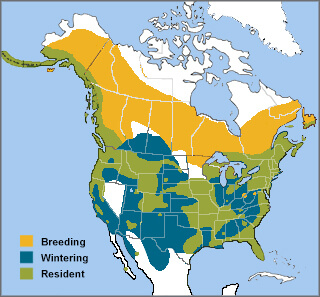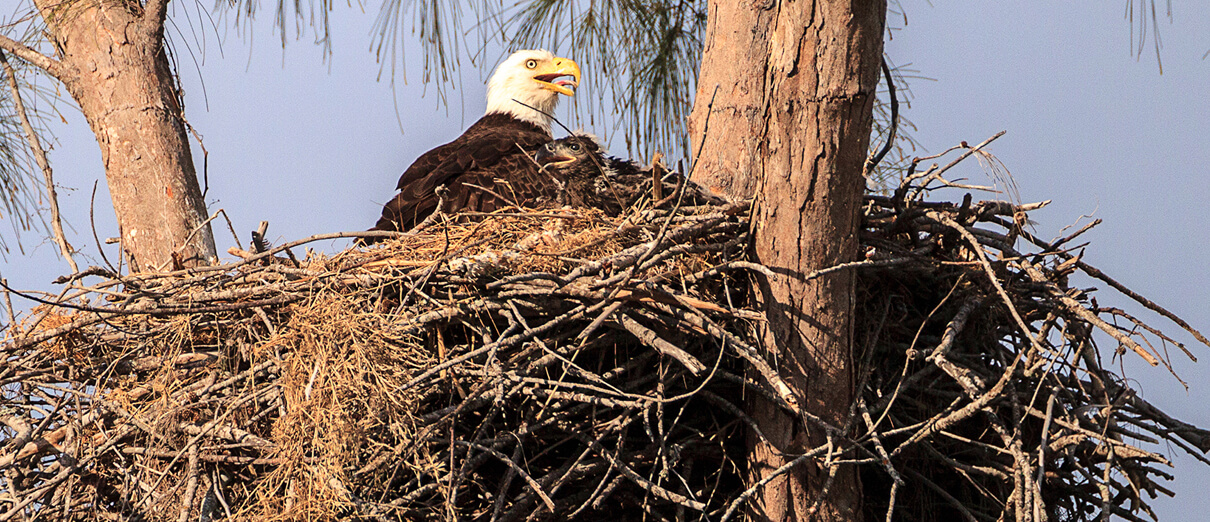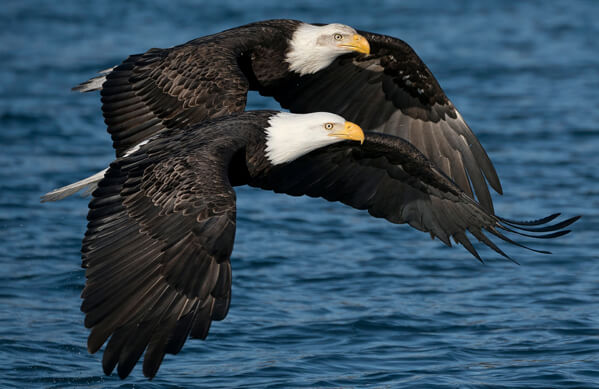
Bald Eagle range map by ABC
The majestic Bald Eagle is the only eagle species found solely in North America. It is well-known, even to non-birders, as the national symbol of the United States, an honor it was granted in 1782. The Golden Eagle, also found in North America, is more widely distributed, occurring as well in Eurasia and even some parts of northern Africa.
The Bald Eagle's Latin name accurately reflects its appearance and habits: Hali and aiētos mean “sea eagle,” and leuco and cephalos mean “white head.” The use of the word "Bald" in its English name does not mean hairless; rather, it derives from the Middle English word “balde,” which means shining white. This distinctive white head and matching white tail make adult Bald Eagles easy to identify, even from a distance.
Although North American field guides place the Bald and Golden Eagles in close proximity, the two are not closely related.
Regal Relatives
The Bald Eagle belongs to a group of fish- and carrion-eating raptors known as sea- (or fish-) eagles. Sea-eagles are always found close to water; their large, arched beaks, bare lower legs, and roughened toe pads help them snatch fish from the water as they hunt. Sea-eagles are also adept kleptoparasites, stealing the catches of other birds such as the Osprey.
The Bald Eagle is considered half of a species pair with its Old World counterpart, the White-tailed Sea-eagle of Eurasia. The latter lacks the white head of the Bald Eagle and has a slightly larger wingspan; otherwise, these closely related species share the same habitat, food, and nesting preferences. Another close relative, the enormous Steller's Sea-eagle of Asia, is at 20 pounds one of the largest eagles in the world, alongside the unrelated but similarly sized Harpy Eagle of Central and South America.
The widespread Golden Eagle is more closely related to hawks found in the Buteo genus, such as the Red-tailed and Red-shouldered Hawks, than to the Bald Eagle! The Golden Eagle is part of a group known as "booted" eagles, which have legs feathered down to their feet. These eagles favor drier, more inland haunts, and prey upon a wide variety of mammals, rather than fish.
New World Eagle
The Bald Eagle is a North American specialty, found from Alaska through Canada into the lower 48 U.S. states, even moving as far south as northern Mexico during the winter. It is considered a partial migrant — individuals in the northern parts of the range often move south during extremely cold weather, as this species needs open water to hunt.
The Bald Eagle's call is a decidedly un-regal, high-pitched squeaking sound. In TV shows and movies, the loud, low scream of the Red-tailed Hawk, which presumably sounds more majestic or fearsome, is often dubbed over the on-screen image of an eagle.
Listen here:
(Audio: Paul Marvin, XC150215. Accessible at www.xeno-canto.org/150215)
Compare to a Red-tailed Hawk:
(Audio: Peter Ward and Ken Hall, XC603734. Accessible at www.xeno-canto.org/603734)
Frequent Fisher
True to its nickname of Fish Eagle, the Bald Eagle dines mainly on fish either snatched from the water's surface or stolen from another bird. But this eagle, being a keen opportunist, will also hunt waterfowl, small mammals, and reptiles and eat carrion and garbage. Its scavenging habit sometimes leads to trouble, as game-animal gut piles left by human hunters often contain fragments of lead ammunition, which eagles accidentally ingest. Even small amounts of lead can be enough to poison, and eventually kill, an eagle.
During the fall and winter, the Bald Eagle can become surprisingly social, congregating in large groups sometimes numbering hundreds of birds. This communal gathering often occurs in response to a superabundance of easy prey — during annual salmon runs, for example.
Cartwheeling Courtship
Like the Tundra Swan and Whooping Crane, the Bald Eagle usually stays with the same mate for life. While courting, a pair flies high, links talons, then plummets toward the ground, spinning wildly. This “cartwheel display” ends only when the pair breaks their grip, usually just before they hit the ground. Other aerial courtship displays include "rollercoaster flight," when an eagle flies high, then folds its wings and plunges toward the ground, swooping back up at the last second. Pairs also engage in mutual chases, rolling and diving through the air in tandem.
A Bald Eagle pair aggressively defends a territory and nest during the breeding season. Both male and female work together to build their nest, an enormous platform of large sticks lined with grass, plant stalks, sod, and other soft materials. The nest is built high in a large tree, usually close to water. In the absence of a suitable tree, an eagle pair may nest on a cliff or even on the ground.

Bald Eagle adult and chick at nest. Photo by Sunflower Momma, Shutterstock.
A mated pair of Bald Eagles will reuse the same nest each year, adding new material again and again. Sometimes these structures become so large and unwieldy that they take down the trees they're built upon. Bald Eagle nests are some of the largest bird nests in the world — the largest ever recorded was in Florida, and measured 9.5 feet in diameter and 20 feet deep, weighing almost three tons!
The female Bald Eagle lays one to three eggs, which both parents take turns incubating. After about a month, the young hatch, already covered in light gray down. The adults guard and feed the young eagles, which grow quickly and are ready to fledge in 10 to 12 weeks. Juvenile Bald Eagles have mottled brown-and-white plumage, and are sometimes misidentified as Golden Eagles. They acquire the characteristic white head and tail of adults at between four and five years old.
Conservation Success — and Continuing Challenges
By the late 1900s, Bald Eagles had become increasingly rare — victims of trapping, shooting, and poisoning, plus nesting failure caused by DDT and other pesticides. The Bald Eagle Protection Act, passed in 1940 and changed in 1962 to include the Golden Eagle, provides protection to both North American eagle species, prohibiting the taking or possession of eagles or any eagle parts, including feathers, eggs, and nests. The southern subspecies of the Bald Eagle was listed as Endangered under the Endangered Species Preservation Act in 1967, and in 1978, all Bald Eagles present in the lower 48 states, regardless of subspecies, were afforded protection under the Endangered Species Act (ESA). Populations began to rebound after the more toxic pesticides were banned in the 1970s, and the bird was removed from the endangered species list in 2007.
Although the Bald Eagle has made a successful comeback, it continues to face a variety of threats: collision risks from wind turbines, communications towers, and powerlines; lead poisoning; oil spills; dangers posed by newer pesticides; and habitat loss.
ABC has stepped up to address these continuing challenges. Our Bird-Smart Wind Energy campaign works to protect eagles and other U.S. birds from the threat of poorly sited wind turbines. Our Conservation Advocacy division continues to defend critical legislation such as the ESA and to promote the conservation and restoration of public lands for the benefit of the Bald Eagle and other North American birds.
Donate to support ABC's conservation mission!



















































